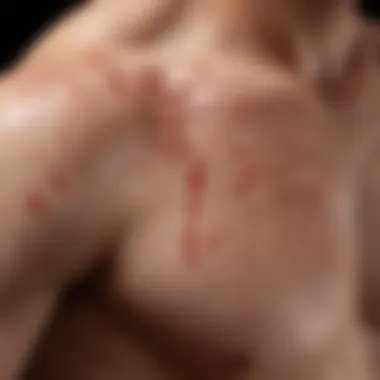Effective Strategies for Managing Heat Rash


Intro
Heat rash, or miliaria, is a common skin issue that occurs when sweat glands become clogged. It affects various individuals, especially in hot and humid conditions. Understanding heat rash involves recognizing its causes and symptoms. Heat rash can present as small, red bumps or blisters, often accompanied by itching and discomfort.
The importance of managing heat rash cannot be overstated. It informs individuals how to adapt their skin care routines in warm climates. This knowledge equips people to take preventive actions and seek effective treatment options. People should be aware of the impact of excessive sweating on their skin health.
By examining the causes and manifestations of heat rash, one can develop effective strategies to alleviate its effects. This article aims to provide insights into heat rash while offering practical and scientific information for a thorough comprehension.
Understanding Heat Rash
Understanding heat rash is vital for anyone living in or visiting warm climates. This skin condition can be uncomfortable and may lead to further skin issues if not managed properly. Heat rash, or miliaria, occurs when sweat gets trapped under the skin. Recognizing its symptoms early on could be beneficial. Knowledge about the various types of heat rash allows individuals to identify and address their particular situation more effectively. This helps reduce discomfort and enhances overall skin health in hot weather.
Definition and Overview
Heat rash is a common and often temporary skin condition resulting from excessive sweating and blocked sweat ducts. The body produces sweat to regulate its temperature, especially during heat exposure. Under certain conditions, sweat may not reach the surface of the skin, where it can evaporate. Instead, it remains trapped, leading to irritation, redness, and sometimes itching or discomfort. It's important to understand this condition as it is not just a minor nuisance; it can significantly affect one’s quality of life during hot seasons.
Types of Heat Rash
Different types of heat rash exhibit distinct characteristics. Recognizing these variations can provide insights into the best management practices for each case.
Crystalline Miliaria
Crystalline miliaria is the mildest form of heat rash. It is characterized by tiny, clear blisters that form on the skin. These blisters are usually painless and may occur in areas where sweat is abundant. The primary aspect of crystalline miliaria is its ability to appear suddenly in high-temperature environments. It serves as an important reminder of how our skin reacts to excess moisture. One of its advantages is the brief duration it tends to have. This type of rash typically resolves on its own when the environment cools down. However, it is essential to keep the affected area dry to prevent further irritation.
Papular Miliaria
Papular miliaria appears as small, red bumps on the skin. It often develops in warmer climates or after vigorous physical activity. The red color indicates that inflammation is present, making it more noticeable compared to crystalline miliaria. This type of rash can be itchy and may require a little more attention to resolve. The unique feature of papular miliaria is that it can sometimes persist longer than the crystalline type. Although it often clears up with proper care, ignoring it can lead to larger areas of discomfort.
Pustular Miliaria
Pustular miliaria is the most severe form of heat rash. This rash presents as red bumps filled with pus and is often associated with bacterial infection. It can cause significant discomfort and often requires medical intervention. The key characteristic of pustular miliaria is its association with a more acute inflammatory response, making it a serious concern. The unique disadvantage of this type is the potential for scarring if not treated promptly and effectively. Thus, it becomes necessary to monitor any symptoms closely and to seek medical advice if the rash does not improve or worsens.
Understanding these types of heat rash enhances the efficacy of preventive and treatment measures. Being able to identify the specific type and respond appropriately can significantly improve the management of the condition.
Causes of Heat Rash
Understanding the causes of heat rash provides essential insights into its prevention and management. Heat rash arises primarily from the body's struggle to regulate temperature, particularly in conditions of excessive heat and humidity. By examining the physiological, environmental, and lifestyle factors that contribute to this condition, individuals can adopt effective strategies to minimize the occurrence of heat rash. Being aware of these causes not only helps in individual skin care but also raises awareness in community settings, allowing for better overall public health practices.
Physiological Factors
Body Temperature Regulation
Body temperature regulation is a critical process that involves various physiological mechanisms. The human body aims to maintain a core temperature around 37 degrees Celsius. When the temperature rises, the body activates cooling mechanisms including dilation of blood vessels and increased sweating. However, when sweat ducts become blocked, the sweat cannot escape, leading to heat rash. This phenomenon highlights the delicate balance the body maintains in conditions that challenge its thermal homeostasis. Understanding this regulation helps in recognizing why heat rash develops, especially in vulnerable individuals.
Sweating Mechanisms
Sweating is a natural response to heat. It helps cool the body through evaporation. When the body overheats, sweat glands produce moisture to evaporate heat away. The efficiency of this process can be drastically impaired in high humidity where evaporation is limited. This leads to increased moisture on the skin surface, creating ideal conditions for heat rash to occur. Recognizing how sweating functions under varying conditions is crucial for preventing heat-related issues, including skin rashes.
Environmental Influences
High Humidity Levels
High humidity levels play a significant role in the development of heat rash. When humidity is high, the air is saturated with moisture, reducing the effectiveness of sweat evaporation. This results in a buildup of sweat on the skin, which can clog sweat ducts and lead to rashes. The unique feature of high humidity is that it exacerbates the body’s normal cooling processes, making it increasingly difficult to cool down. Awareness of weather conditions can aid in preventative measures during summer months.


Heat Exposure
Direct heat exposure also significantly contributes to heat rash. When individuals spend extended periods outdoors in direct sunlight or hot environments, the body generates more sweat. If inadequate cooling practices are employed, this can lead to clogged sweat ducts. The crucial aspect of heat exposure is its predictability; individuals can take informed steps to manage their time in the heat. Understanding one's environment and taking proactive measures can essentially lower the risk of heat rash occurrence.
Lifestyle Contributions
Restrictive Clothing
Restrictive clothing can exacerbate the issue of heat rash by limiting airflow to the skin. Fabrics that trap heat and moisture can prevent sweat from evaporating, thereby contributing to skin irritation. Loose-fitting and breathable fabrics are generally beneficial choices for warmer climates, allowing for better air circulation. Changing clothing habits can therefore significantly reduce the risk of developing heat rash in susceptible individuals.
Physical Activity
Physical activity itself can trigger heat rash, particularly in warm conditions. Engaging in exercise increases body temperature, leading to an uptick in sweating. If exercise is performed in a humid environment, the body may not effectively regulate temperature, heightening the chance of heat rash. However, staying active is important for overall health. Scheduling workouts during cooler times and incorporating hydration strategies can mitigate the risks associated with physical activity in the heat.
Identifying Heat Rash
Identifying heat rash is a crucial step in managing this common skin condition. Understanding its symptoms and recognizing its presence can lead to more effective treatment and prevention strategies. Heat rash typically appears during warmer weather or periods of heavy sweating, making awareness of its signs important for individuals in such climates. By correctly identifying heat rash, individuals can take prompt action to soothe their skin and avoid further irritation.
Symptoms and Signs
Recognizing the symptoms of heat rash plays a pivotal role in swift management. Several signs indicate the presence of the rash, primarily characterized by red bumps and itching sensations.
Red Bumps
Red bumps are one of the most conspicuous signs of heat rash. These small, inflamed areas appear on the skin when sweat ducts become blocked. The key characteristic of these red bumps is their size and color, typically resembling tiny blisters or acne. They arise from an accumulation of sweat and can be quite numerous in affected areas.
The presence of red bumps serves as an important indicator for the affected individual. Not only do they signify heat rash, but they also prompt prompt treatment to alleviate discomfort. A notable aspect of red bumps is their tendency to appear primarily in areas where skin rubs against skin or clothing, such as the neck, back, and underarms. This specificity helps differentiate heat rash from other skin issues, streamlining the identification process.
Itching or Burning Sensations
Itching or burning sensations are critical components to note when identifying heat rash. This discomfort is often caused by the body’s inflammatory response to irritation from sweat accumulation. The key characteristic here is the severity of itchiness, which can vary from mild to intense, impacting the individual’s daily activities.
The unique feature of these sensations is their immediacy; they often follow the appearance of red bumps, providing a nearly simultaneous manifestation of heat rash symptoms. Notably, persistent itching can lead to scratching, which further aggravates the skin and complicates healing. Thus, recognizing this sensation not only aids in identification but also emphasizes the need for immediate soothing treatments to prevent exacerbation of the rash.
Differentiating from Other Skin Conditions
Identifying heat rash also involves distinguishing it from other skin conditions, such as eczema and folliculitis. Understanding these differences is vital for proper diagnosis and treatment.
Comparison with Eczema
When comparing heat rash with eczema, it is essential to note that both conditions may present with red patches but differ in causes and characteristics. Eczema is typically chronic and can occur year-round, while heat rash is a transient reaction primarily triggered by heat and humidity. The key aspect that makes this comparison beneficial is the persistence of eczema symptoms, which often accompany severe dryness and scaling of the skin. Recognizing this contrast can lead individuals to seek appropriate treatment. Eczema may require long-term management strategies, whereas heat rash may resolve itself with simple cooling measures.
Distinction from Folliculitis
Distinguishing heat rash from folliculitis is another important aspect of identification. Folliculitis involves inflammation of hair follicles and often presents as pus-filled bumps, which are not typical in heat rash cases. The key feature here is the nature of the bumps; folliculitis has a more infectious element, sometimes resulting in pain and irritation beyond that experienced with heat rash. Understanding this difference is beneficial for guiding treatment approaches. Misidentifying folliculitis as heat rash may lead to ineffective remedies, as each condition requires targeted intervention.
Preventive Measures for Heat Rash
Preventing heat rash can significantly improve skin health, especially in warm climates. People experience heat rash when sweat ducts become blocked, leading to irritation. By implementing various preventive strategies, individuals can reduce the likelihood of developing this condition. This section discusses environmental adaptations, personal hygiene practices, and mindful physical activity as effective preventive measures.
Environmental Adaptations
Choosing Appropriate Clothing
Choosing appropriate clothing is essential in managing heat rash. When selecting garments, prioritize loose-fitting, breathable fabrics like cotton or linen. These materials help to allow air circulation, which minimizes sweat buildup on the skin. Additionally, lighter colors reflect sunlight, reducing heat absorption.


A key characteristic of choosing appropriate clothing is its ability to create a barrier against perspiration. It is a popular choice among those looking to remain comfortable in hot weather. The unique feature of breathable clothing is that it can significantly lower the risk of sweat duct blockage. However, while choosing comfortable fabrics offers protection, it may require more frequent washing due to sweat accumulation.
Creating Cooler Living Spaces
Creating cooler living spaces plays a critical role in preventing heat rash. This can involve using air conditioning, fans, or even strategically placing shade in outdoor areas. Cooling your environment helps to maintain a lower temperature, reducing the chances of excessive sweating, which leads to heat rash.
An important feature of cooler living spaces is the comfort level they provide. Individuals are more inclined to spend time in these spaces, thus avoiding heat rash triggers. The advantage of having a cooler home is the overall enhancement of well-being. On the downside, the reliance on air conditioning can lead to higher energy costs.
Personal Hygiene Practices
Regular Showers
Regular showers help in preventing heat rash by removing sweat and bacteria from the skin. Cleansing the skin regularly reduces the likelihood of blocked sweat ducts, making it an essential practice during warmer months.
The key characteristic of taking regular showers is that it maintains skin cleanliness and hydration. It is beneficial in this guide as it directly addresses some root causes of heat rash. The unique feature of regular showers is that they can be tailored based on personal preferences, such as water temperature and shower duration. However, excessive showering with hot water can lead to skin dryness, which can aggravate other skin issues.
Use of Antiperspirants
Using antiperspirants is another method to manage heat rash effectively. These products help block sweat production and are available in various formulations. This inhibits sweat from accumulating on the skin, thus diminishing the chances of developing rash.
A key characteristic of antiperspirants is their active ingredient, aluminum chloride, which is effective in preventing sweating. Their popularity is based on their direct action against perspiration. The unique feature of antiperspirants is that they can be applied daily and are versatile for both body and face. However, some may experience sensitivity or adverse reactions to specific ingredients, so testing products prior to widespread use is advised.
Mindful Physical Activity
Scheduling Workouts Wisely
Scheduling workouts wisely is important to mitigate the risk of heat rash. Engaging in physical activity during early mornings or late evenings when temperatures are cooler can minimize sweat production. Additionally, consider indoor workouts or use air-conditioned gyms when the weather is excessively hot.
The key characteristic of planning workout times is to reduce exposure to heat. This choice is beneficial in this article, as it directly impacts the effectiveness of physical activity while keeping skin health in mind. The unique feature of scheduling workouts wisely is that it requires only slight adjustments to one's routine. On the negative side, it may be challenging for those with fixed schedules to adapt.
Utilizing Cooling Strategies
Utilizing cooling strategies during physical activity can greatly enhance comfort and reduce the likelihood of developing heat rash. This includes approaching outdoor exercise with breaks, wearing cooling towels, or immersing in cool water. Such methods assist in regulating body temperature during exertion.
A notable characteristic of these strategies is their focus on immediate relief from heat. They are a popular choice among athletes looking to maintain performance without sacrificing health. The unique feature of cooling strategies is their adaptability; individuals can choose methods that work best for them. However, relying exclusively on these methods may make some forget other preventive measures, leading to neglect in other areas of skin care.
Effective Treatments for Heat Rash
Effective treatments for heat rash are essential for individuals experiencing this uncomfortable skin condition. Understanding the array of available treatments enables better management and relief of symptoms. By addressing heat rash through a combination of topical treatments, home remedies, and recognizing when medical advice is necessary, individuals can effectively mitigate discomfort and promote skin healing.
Topical Treatments
Topical treatments provide immediate relief and are often the first line of defense against heat rash. These solutions target the localized symptoms and help to alleviate discomfort and promote healing.
Calamine Lotion
Calamine lotion is a popular topical treatment for heat rash. One of its key characteristics is its soothing properties. It effectively calms irritated skin and reduces itching, making it a beneficial choice for relief.
The unique feature of calamine lotion is its dual action. It not only soothes the skin but also dries out excess moisture. This can be particularly helpful in preventing further irritation. However, its effectiveness may vary from person to person, and some may find it less beneficial in severe cases of heat rash.
Corticosteroid Creams
Corticosteroid creams represent another effective topical treatment. These creams work by reducing inflammation and relieving itching. Their key characteristic lies in their strength, making them especially helpful for more severe instances of heat rash.


A unique feature of corticosteroid creams is their ability to penetrate the skin barrier effectively. This leads to faster relief from symptoms. Nevertheless, long-term use is not advisable due to potential side effects, such as skin thinning. Therefore, these creams should be used judiciously and under guidance.
Home Remedies
Home remedies often offer simple, cost-effective solutions for managing heat rash. These methods can complement topical treatments and help ensure comfort and healing.
Cool Compresses
Cool compresses are a common home remedy for heat rash. The essence of this method is the immediate cooling effect they provide. They relieve discomfort by reducing skin temperature and calming irritation.
A key characteristic of cool compresses is their ease of use. Simply soak a clean cloth in cold water and apply it to the affected area. However, ensure that the compress is not too cold, as this could lead to additional irritation. Overall, this method is safe and can be repeated as needed, making it a favorable option for many.
Natural Oils
Natural oils, such as coconut oil or tea tree oil, also serve as effective home remedies for heat rash. Their key characteristic is their moisturizing properties, which can soothe dry, irritated skin. This makes them a popular option among individuals looking for gentle relief.
The unique feature of natural oils is their versatility. They can be applied directly to the skin or mixed with other ingredients for enhanced benefits. However, some people may experience allergies or reactions to certain oils. Therefore, it is recommended to perform a patch test before extensive use.
When to Seek Medical Advice
Some cases of heat rash may require professional medical attention. Understanding when to seek help is crucial in preventing complications and ensuring effective treatment.
Persistent Symptoms
Persistent symptoms of heat rash warrant concern. If irritation continues despite home treatments or topical solutions, it is wise to consult a healthcare professional. The key characteristic here is the duration and severity of symptoms; prolonged discomfort may indicate an underlying issue. Seeking guidance can help avoid worsening the condition and ensure proper treatment.
Signs of Infection
Signs of infection are critical indicators that medical help is necessary. Symptoms such as increased redness, swelling, or discharge are telltale signs that the rash may have become infected. The importance of recognition lies in the potential for serious health implications if left untreated. Prompt evaluation by a healthcare provider is crucial in these scenarios to prevent serious complications.
Long-term Management of Heat Rash
Long-term management of heat rash is crucial for individuals who are frequently exposed to hot and humid conditions. This section examines several key elements in maintaining skin health, ensuring comfort, and preventing recurrence of the condition. With an effective management plan, one can significantly reduce the frequency and severity of heat rash episodes.
Adopting a Preventive Mindset
Routine Skin Care Practices
Developing routine skin care practices is essential to manage heat rash effectively. This includes consistent cleansing and moisturizing to maintain skin health and hydration. Keeping the skin clean removes sweat and debris that may clog sweat glands, thereby reducing the risk of heat rash. A key characteristic of routine skin care is its simplicity and accessibility. Many common products are readily available and easy to incorporate into daily life.
However, choosing the right products is essential. It is best to opt for non-comedogenic, hypoallergenic, and fragrance-free options to avoid irritation. A unique feature of proper skin care is that it addresses not only heat rash but also enhances overall skin condition. Therefore, it provides a dual advantage of both immediate relief as well as long-term skin care benefits.
Monitoring Weather Conditions
Monitoring weather conditions plays a significant role in managing heat rash long term. By being aware of daily temperatures and humidity levels, individuals can make informed choices about their activities. For instance, scheduling outdoor tasks during cooler parts of the day can help minimize sweat exposure. The ability to adjust plans based on weather is a beneficial aspect of monitoring weather conditions.
The unique feature of this approach is its proactive nature. Instead of waiting for a heat rash to develop, individuals can take preventive actions in advance. An upside of this method is that it empowers individuals. However, it requires awareness and sometimes may limit activities during warmer weather.
Educational Resources
Understanding Skin Health
Understanding skin health encompasses a broader awareness of one's own skin and its needs. This knowledge assists individuals in recognizing potential triggers for heat rash, thus enabling better personal care decisions. An essential characteristic of this aspect is its emphasis on education, which can lead to informed choices regarding skin care. In this article, understanding skin health is beneficial because it promotes proactive engagement in one's own well-being.
The unique feature is that it encourages lifelong learning. By understanding skin health, individuals can adapt their practices over time and respond better to changes in their skin due to various environmental factors. This ongoing education presents an advantage but may require time and commitment.
Keeping Informed on Dermatological Advances
Keeping informed about dermatological advances is vital for individuals managing heat rash. This involves staying updated on new treatments, products, and research findings that improve skin health. A key characteristic of this segment is that it reflects the dynamic nature of dermatological science. Consequently, it plays a vital role in adapting effective management strategies.
The unique aspect here is the potential for continuous improvement. Advancements in skin care technology and formulations often lead to more efficient solutions for conditions like heat rash. An advantage is being ahead of the curve regarding effective skin care options. However, the need for occasional research can be time-consuming and may require discernment in filtering credible sources.



